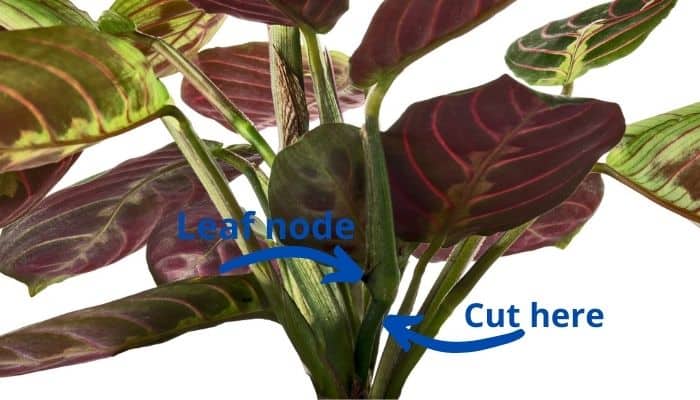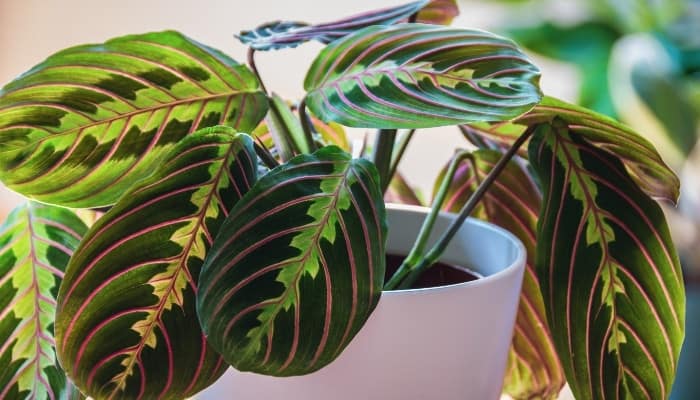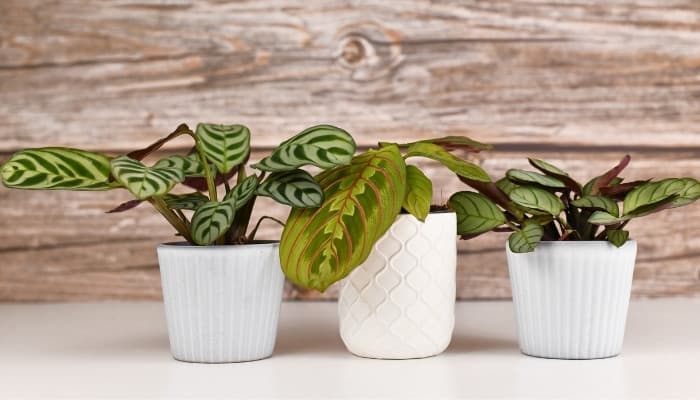The prayer plant, renowned for its stunning greenery and the way it tenderly raises its leaves towards the sky at sunset, is the top preference for numerous indoor plant enthusiasts.
But, once you have one, you’ll undoubtedly want more, which brings us to the topic of how to propagate the prayer plant at home.
How do you propagate a prayer plant? Prayer plants can be propagated from seed, cuttings, root division, and slips. Cuttings may be rooted in either water or soil, but divisions and slips are typically only rooted in soil. While sprouting seeds is possible, this plant rarely produces seeds, so this method is not very feasible.
While propagating a prayer plant is not particularly difficult, there are specific steps to follow to ensure your plant has the best possible opportunity to thrive.
To learn more on propagating prayer plants the right way, read on.
Prayer Plant Propagation: Cuttings in Water
Propagating a prayer plant in water can be done by following the steps below.
1. Take a Cutting From the Stem of the Main Plant
Inspect your plant stem for a good place to take a cutting. Next, find the leaf nodes – this is where the leaves will eventually form on the stem.
Position your scissors beneath the leaf node and snip the stem while being careful not to damage the leaf node in the process.
The roots will form in this area – so treat it with care. Ensure that you make a clean cut with a sharp pair of sterilized pruning scissors or shears.

2. Dip the Stem in Rooting Hormone
First, make sure the stem is dry so that it doesn’t pick up too much powder. Then, dip the end of the cutting stem into powdered rooting hormone.
You should aim to dip at least 1 inch of the stem into the powder.
Some well-known rooting hormones include:
- Hormex Rooting Powder (check price on Amazon)
- Garden Safe Rooting Hormone (check price on Amazon)
- Miracle-Gro FastRoot Dry Powder (check price on Amazon)
3. Place the Cutting in Distilled Water
Ensure that the water only covers the lower part of the cutting’s stem. Make a point of changing the water every second day.
Wait until the cutting roots are 1 inch long before planting the cutting into a peat and perlite mix.
This growth usually takes around two weeks, but some prayer plants can take up to a month to produce suitable root growth, so be patient.
Prayer Plant Propagation: Cuttings in Soil
You can also effectively propagate a prayer plant with cuttings in soil. It’s ideal to take cuttings from spring to early summer. Follow the simple steps below.
1. Take a Cutting Near the Stem’s Base
Select your cutting from a vigorous stem on the plant. Cut towards the end of the stem below the leaf nodes.
Be careful not to damage the leaf nodes in the process and focus on making a clean cut. As always, use sterilized pruning scissors or shears.
2. Place the Cutting in a Peat and Perlite Mixture
Create a growing medium with one part compost, one part peat moss, and one part perlite (or vermiculite).
If you don’t have any compost readily available, you can mix one part perlite with one part peat moss.
The compost should never make up more than one-third of the growing medium.
If you’ve never created compost before – it’s easy and well worth the effort. Learn all about composting here.
3. Cover the Growing Medium With Plastic
Moisture and heat are required to get the prayer plant cutting to sprout roots and grow.
To create heat and trap moisture, cover the growing medium and pot/container with plastic.
Make a few holes in the plastic with a pair of scissors to allow limited airflow to the growing medium.
4. Place Your Cutting in a Sunny Spot
Placing the cutting in a sunny spot will help raise the temperature and create a prime growing environment for the roots.
Prayer Plant Propagation: Root Division
This propagation method is simpler than it sounds and is best done when repotting your prayer plant.
Repotting is only required every two years or when the plant becomes root-bound. By following the easy steps below, you will soon have a whole family of prayer plants.
1. Shake Excess Soil off the Roots
Remove the prayer plant from its current container and gently shake to remove excess soil. Ensure the roots are clearly visible to allow for easy division.
2. Divide the Plant Into a Few Portions
Identify a section of the plant with its own root system, and then gently divide the plant into a few portions using your hands or a small pocket knife.
Take care when separating the roots, as they can be fragile.
If the roots are too tangled, use a pair of sharp, sterilized scissors to carefully separate them, ensuring each plant has a good root system.
3. Work Quickly To Avoid Drying Out the Roots
When separating the roots, you must work quickly to prevent the roots from drying out and the plant from undergoing unnecessary stress.
4. Repot the Baby Plants
Place the new plants into a suitably sized container filled with soil, and water them well.
Use well-draining soil that contains peat moss and some sand to create loamy soil perfect for prayer plants.
Prayer Plant Propagation: Slip Division
Slip division is almost the same as root division and closely follows the same steps.
You can obtain your slips from a healthy prayer plant that has lots of healthy stems and foliage.
1. Remove the Soil From the Roots
Carefully remove the prayer plant from its container and shake off any excess soil on the roots.
2. Separate the Roots To Obtain Plant Slips
Hold the plant upside down and use your fingers to separate the roots and corresponding stems into separate sections.
Take care not to break any stems or pull too roughly on the delicate root system. Ultimately you want to separate the one plant into individual plants.
3. Plant the Slips Into Suitably Sized Containers
Plant the slips into containers that are just as deep as the one they were in initially.
Caring for Your Newly Rooted Prayer Plant: 5 Tips

- Use filtered water or allow water to stand for 24 hours before watering the plant. This prevents brown tips on the leaves caused by chlorine in the water.
- Keep the soil moist and not saturated; watering little and often is best. Soggy soil can cause root rot in prayer plants.
- Use a spray bottle to mist leaves if the air is dry in your home. This will also prevent the leaves from getting brown tips.
- During the growing season, feed every two weeks with houseplant fertilizer diluted to half the normal strength. Prayer plants are heavy feeders, but you don’t want to burn the roots.
- Place the plant in a warm, well-lit west or south-facing room for optimum leaf color and growth. Avoid putting the prayer plant in direct sunlight as it can burn and bleach leaves.
How Long Does It Take a Prayer Plant to Root in Water?
Most prayer plants will show some root growth within two weeks, but it can take three to four weeks for sufficient growth to appear for planting.
Place your cuttings in a low-light area to encourage speedy root development. Move the plant to a well-lit area once rooting has occurred.
Does Taking Cuttings Hurt the Plant?
The simple answer is no; taking cuttings does not hurt the plant.
Cuttings are a pain-free and effective way to propagate new plants without the hassle of buying new ones, especially if you are expanding your gardening empire on a budget.
Keep in mind that the parent plant you choose to take cuttings from should be well established and healthy so no harm is caused when taking the cuttings.
Can You Take Cuttings Without Rooting Hormone?
Yes, you can take cuttings without using rooting hormones. However, rooting can be a little harder to encourage in some plants, making the use of a rooting hormone very handy.
First, dip the cutting or node end into some water, shake off the excess, and then dip into the rooting hormone powder.
It’s as simple as that, the rooting hormone is now activated, which will encourage root growth.
When rooting without hormone, simply place the cut stem in fresh water and place it in a sunny spot. Refresh the water daily.
How Long Does It Take for a Prayer Plant To Propagate?
Depending on the type of propagation, it can take anything between 2 to 4 weeks for the plant to propagate effectively.
In some cases, this can take longer – patience is key.
How Many Prayer Plant Varieties Are There?
There are about 50 varieties of prayer plant, of which the Maranta leuconeura is the most common; its leaves are green with dark irregular spots on them.
The “herringbone plant” is also quite popular – it’s a beautiful plant sporting red veins on dark green leaves.
In addition, the underside of the leaf is bright red, creating a stunning contrast with the green.
Where Is the Leaf Node on a Prayer Plant?
You can find the node where the leaf stem, called the petiole, attaches to the main stem. Usually, you will see a slight bulge at this point on the main stem.
Roots will start growing from the base of your cutting.
When Is the Best Time To Take Cuttings?
The optimum time to take cuttings is from mid-spring to early summer, as many plants produce new shoots during this period.
Using a sharp pair of scissors, remove the shoots – these will readily root in moist soil.
Can You Propagate a Prayer Plant From Root Nodules?
Some prayer plants have little balls on their roots. These are called nodules and are where prayer plants store their energy.
While a root nodule cannot be planted alone to grow a prayer plant, you can propagate the plant using a root division with root nodules.
Can You Propagate Calathea From Cuttings?
The Calathea is a separate genus in the prayer plant family and is often mistaken as such by consumers as they look so similar.
While you can propagate this plant by root division, unfortunately, it is not possible to propagate the Calathea from stem and leaf cuttings as the plant doesn’t seem to have the plant tissue required to develop roots and grow into a new plant.
What Do Prayer Plant Seeds Look Like?
If the prayer plant decides to flower – it is very rare – this will happen during spring and summer.
Unfortunately, the produced seeds are incredibly tiny and can be challenging to harvest, making finding a viable seed to propagate quite unlikely.
The seed is a tiny black/brown seed.
How To Harvest Prayer Plant Seeds
On the rare occasion that prayer plants do flower, you will witness the most beautiful white or purple flowers on long stems. The seeds are tiny, though.
If you plan to harvest prayer plant seeds, allow the flower to wilt and dry before shaking the seeds onto a damp paper towel.
It’s best to plant them immediately in moist soil because they are so tiny, they are hard to store.
Can You Propagate Prayer Plants From Seeds?
Planting seeds isn’t the most popular method of propagation when it comes to prayer plants.
Indoor prayer plants don’t often flower, and without flowers, there are no seeds to germinate.
It’s also challenging to purchase the seeds; however, the plants are easily available online and at local garden centers, making other propagation methods more common for this plant.
If you do get your hands on some prayer plant seeds, here’s how to propagate them:
1. Use a Moist Growing Medium
As previously mentioned, you can mix your own growing medium using one part of compost, one part peat moss, and one part perlite (or vermiculite).
Fill a wide, shallow pot with the growing medium and plant your seeds. Make sure the soil is not saturated.
2. Keep the Seeds Moist
Cut a few small holes in a clear plastic bag and place it over the pot. This will keep the moisture in and also allow for airflow.
The seeds sprout best in a humid environment that’s similar to their homeland (remember, that’s swampy areas of Central and South America).
3. Keep the Seeds Warm
Place the seeds in a warm spot on a sunny window sill, and be careful that they don’t overheat and dry out.
The best temperature to germinate the seeds is between 55 and 65 degrees Fahrenheit (between 12 and 18 degrees Celsius).
How Do Prayer Plants Naturally Reproduce?
If prayer plants are in their natural environment, they will produce flowers and seeds when they fade. The seeds will drop to the soil and self-propagate.
However, prayer plants are native to moist swampy Central and South American tropical forests – chances are if you have one, it’s not in its natural environment.
When the prayer plant is grown outside its natural environment, the best ways to propagate it are via cuttings, slips, and root division.
Conclusion
Propagating a prayer plant can be quite easily done by seed sowing, root division, slips, and cuttings.
If you are sowing seeds or rooting a stem, you should see sufficient progress in two weeks. Of course, root divisions and slips can show varying progress.
If you want to expand your collection of prayer plants, all it takes is a bit of work and a few weeks of patience.

